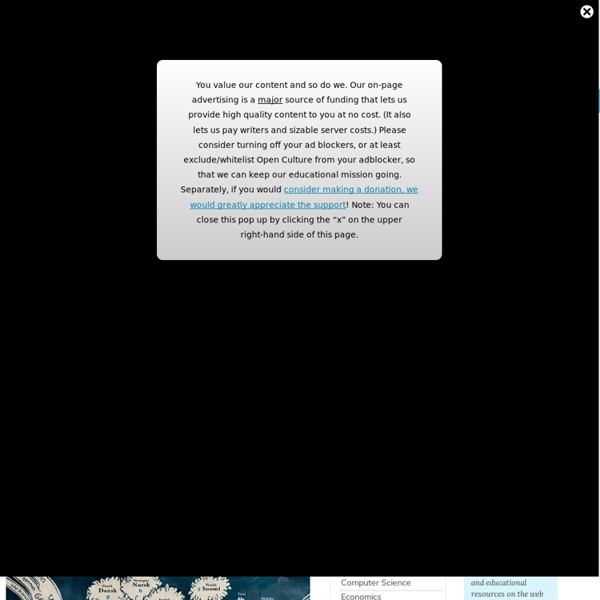Comic Artist Maps the History of Languages with a Linguistic Tree
Using research from Ethnologue, Minna Sundberg created this amazing infographic in the form of a magnificent tree, which illustrates the ancient linguistic links between the world’s languages. Trees and branches are often used by linguists as a visual metaphor to explain language origination. This tree model explains the connections between groups of languages, which all descend from a common ancestral proto-language. In the same way we think of people in a biological family tree, these groups of languages are known as “families” and linguists would say that “daughter languages” within a family are genetically related. This visualization stemmed from Sundberg's own webcomic, Stand Still.
Planeta Comida
Desde hace unos años, la evolución en el ámbito de la alimentación ha permitido que existan nuevas alternativas a la comida tradicional. Han aparecido, por ejemplo, los productos precocinados que facilitan la elaboración de las comidas, y que permiten almacenar en casa gran variedad de alimentos sin ir todos los días a la compra. Planeta Comida analiza cómo ha influido esa nueva ingeniería de la alimentación. La reportera María Pérez se desplaza hasta la capital de los Países Bajos, a Ámsterdam, para degustar la gastronomía holandesa y comprobar que es una de las más cosmopolitas del mundo. Por su parte, Juanlu Martín estará en Nueva York, en Estados Unidos, para presentarnos a Rudy y Lindsay, una joven pareja de científicos que conocen bastante bien el mundo de la alimentación. El reportero Alberto Granados se desplaza a un destino de la geografía española.
La répartition des 23 langues majeures dans le monde en une cartographie
L’infographiste Alberto Lucas Lopez s’est intéressé aux 23 langues les plus usitées dans le monde. De son travail ressort un état des lieux de la répartition des langues maternelles les plus courantes. Il existe plus de 7 000 langues connues. Pourtant, sur les 7,2 milliards d’humains peuplant la Terre, 4,1 milliards partagent 23 langues maternelles à peine. Grâce à une infographie, Alberto Lucas Lopez a entrepris de montrer comment elles étaient réparties dans le monde. Sans surprise, c’est le chinois qui domine l’étude puisqu’il est la langue maternelle de quasiment 2 milliards d’individus.
Samiska - Skolbok
Det samiska språket är släkt med finskan, men så pass olikt att en same och en finne inte förstår varandra. Samiskan är uppdelad i flera olika dialekter som dessutom är så olika varandra att samer som bor långt ifrån varandra inte förstår varandra. Det samiska språket är mycket påverkat av samernas traditionella levnadssätt och är mycket rikt på ord som rör naturen och renskötseln. I renskötseln är samiskan väldigt användbart eftersom det har hundratals ord som rör just renar som inte finns i svenskan eller finskan.
Stand Still. Stay Silent - webcomic, page 196
14 October. 2014 Language trees for the language lovers! I've gathered pretty much all the data for this from ethnologue.com, which is an awesome well of information about language families. And if anyone finds some important language missing let me know!
Inspired Beginners Spanish Audio - Full Lesson Index - Free Podcasts In Spanish - Learn Real Spanish With Notes in Spanish
Welcome to our free ‘Inspired Beginners’ Spanish audio, full of real-world Spanish and learning techniques! You’ll sound Spanish in no time! Find each episode’s audio and notes via the full index of lessons below. You can also subscribe as a podcast.
APPRENTISSAGE des LANGUES: La fenêtre de prédisposition se ferme à l’adolescence
APPRENTISSAGE des LANGUES: La fenêtre de prédisposition se ferme à l’adolescence Actualité publiée il y a 3h29mn PLoS ONE
Danska - Skolbok
H C Andersen, en av Danmarks mes kända författare Danskan är ett nordiskt språk som är starkt påverkat av ”plattyskan”, en tysk dialekt som talas i norra Tyskland längs gränslandet mellan Danmark och Tyskland. Danska talas, förutom i Danmark, också i Sydslesvig, det tyska område rakt söder om Danmark, som var danskt fram till år 1864. Danskan och norskan är dessutom så lika varandra att bokmål i skriven form nästan är identisk med danskan, mycket beroende på den union Danmark och Norge var i fram till 1814. Från Köpenhamn styrs inte bara Jylland, Själland och de andra öarna i det vi oftast tycker är Danmark.



